Family: Tenthredinidae
Family common name: common sawflies
Subfamily: Tenthredininae
Tribe: Tenthredinini
Genus: Tenthredo Linnaeus, 1758
Subgenera: Tenthredo, Adungia, Casipteryx, Cephaledo, Dorhettenyx, Elinopsis, Elinora, Endotethryx, Eurogaster, Maculedo, Metallopeus, Olivacedo, Paratenthredo, Peus, Propodea, Temuledo, Tenthredella, Tenthredina, Zonuledo
The Tenthredinidae are the most species-rich family and are found throughout the world, in all continents but Antarctica. They are known as the “common sawflies”. They can generally be recognized by a cylindrical body and long, segmented antennaeantenna:
the sensory organ emerging from the front of the head, usually between the compound eyes and above the clypeus; includes the flagellum, scape and pedicel
 . Otherwise they come in a variety of colors, size and form (Goulet 1992Goulet 1992:
. Otherwise they come in a variety of colors, size and form (Goulet 1992Goulet 1992:
Goulet H. 1992. The genera and subgenera of the sawflies of Canada and Alaska: Hymenoptera. Symphyta. The insects and arachnids of Canada. Part 20. Agriculture Canada Publication.).
Sawflies in the Tenthredininae subfamily are relatively large in the family, often with distinct colorful markings. Some are wasp-like with black and yellow stripes (Goulet 1992Goulet 1992:
Goulet H. 1992. The genera and subgenera of the sawflies of Canada and Alaska: Hymenoptera. Symphyta. The insects and arachnids of Canada. Part 20. Agriculture Canada Publication.). Many species’ life histories are not known. Some Tenthredininae species feed uniquely, as adults, on flower pollen and other insects (Smith 1993Smith 1993:
Smith DR. 1993. Systematics, life history, and distribution of sawflies. Pp. 3-32. In: Wagner MR and Raffa KF, eds. Sawfly Life History Adaptations to Woody Plants. University of Minnesota Academic Press. 581 pp.). They can be distinguished from other subfamilies by wing venationvenation:
the network of veins on a wing
(Goulet 1992Goulet 1992:
Goulet H. 1992. The genera and subgenera of the sawflies of Canada and Alaska: Hymenoptera. Symphyta. The insects and arachnids of Canada. Part 20. Agriculture Canada Publication.).
Tenthredo is the most species-rich sawfly genus, with incredibly diverse forms, host plants, and behaviors. Species can be recognized by the relatively large size, slender body, angular face features, and often by bright colors and patterns (Smith 1979bSmith 1979b:
Smith DR. 1979b. Symphyta. In: Krombein KV, Hurd PD, Jr., Smith DR, and Burks BD (eds). Catalog of Hymenoptera in America North of Mexico. V. 1. Smithsonian Institution Press, Washington DC. pp. 1-137., Goulet 1992Goulet 1992:
Goulet H. 1992. The genera and subgenera of the sawflies of Canada and Alaska: Hymenoptera. Symphyta. The insects and arachnids of Canada. Part 20. Agriculture Canada Publication.).
There are 978 described extantextant:
in existence; opposite of extinct
species worldwide. There are 143 species that occur in North America (Taeger et al. 2010Taeger et al. 2010:
Taeger A, Blank SM, and Liston AD. 2010. World Catalog of Symphyta (Hymenoptera). Zootaxa 2580: 1-1064.).
Subfamily characters
 vein M and 1m-cu parallel (Goulet 1992Goulet 1992:
vein M and 1m-cu parallel (Goulet 1992Goulet 1992: vein R bent at basebase:
vein R bent at basebase: Sc (Goulet 1992Goulet 1992:
Sc (Goulet 1992Goulet 1992: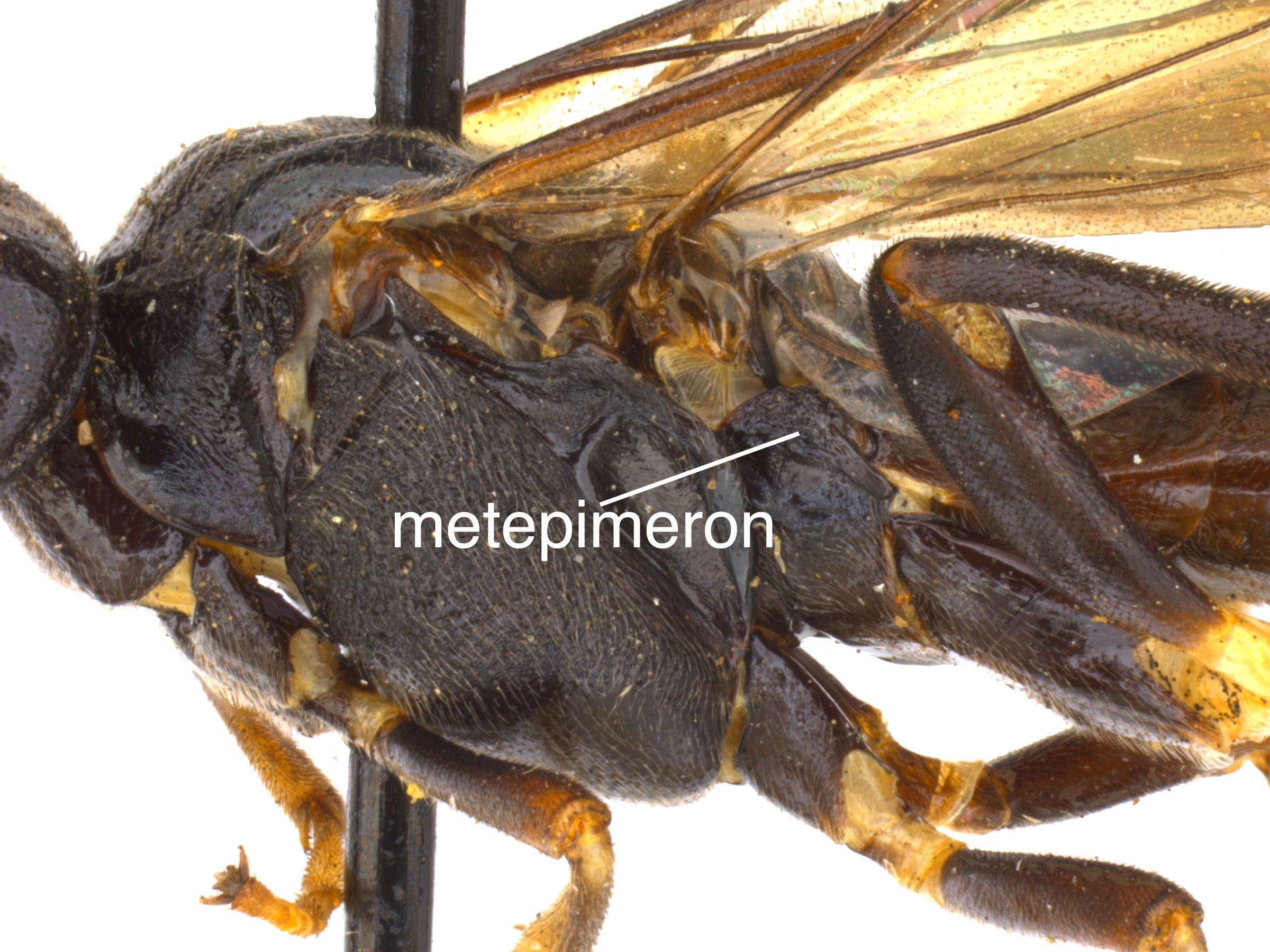 separated from metepisternummetepisternum:
separated from metepisternummetepisternum: by distinct furrowfurrow:
by distinct furrowfurrow: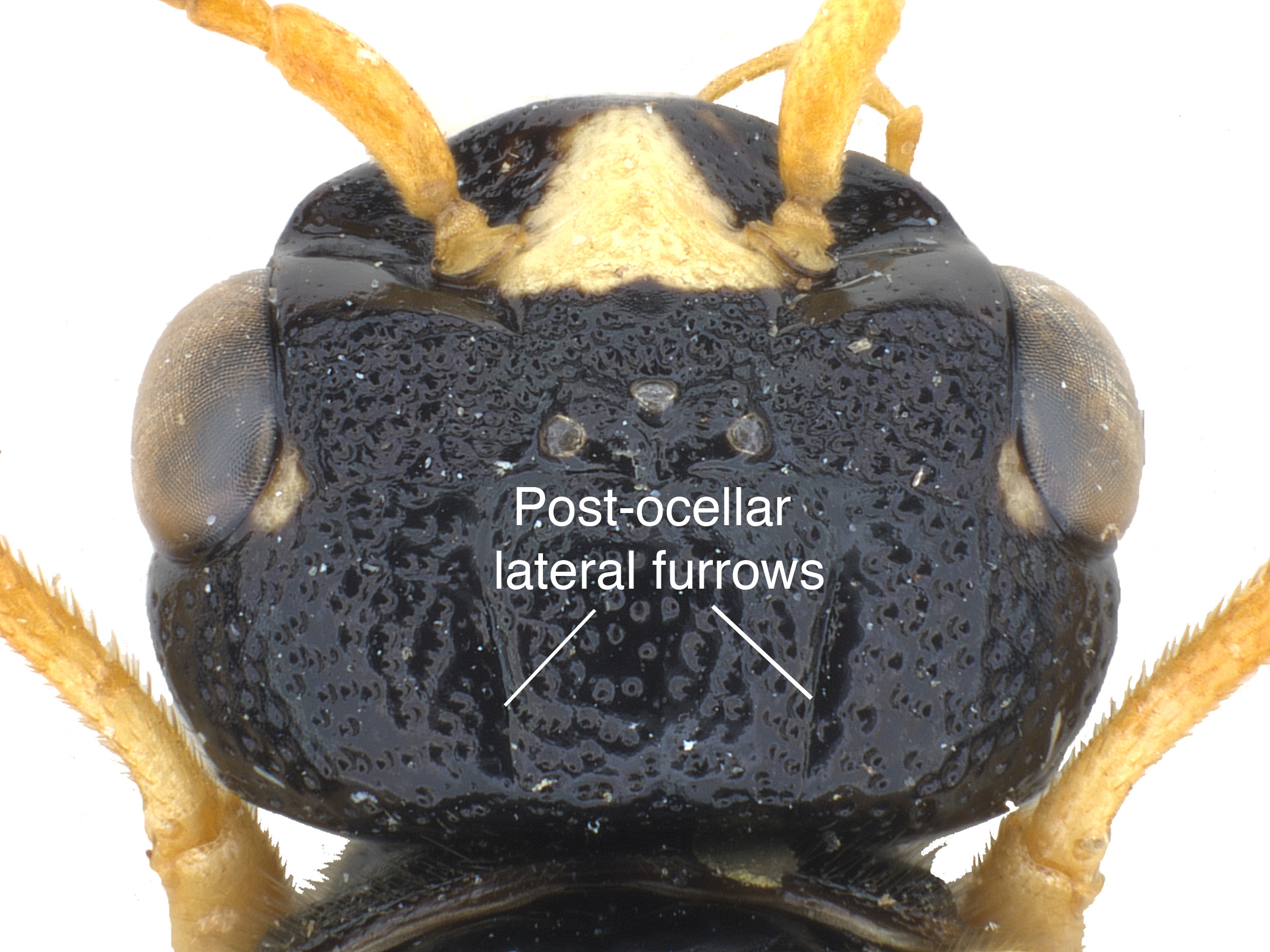 (Goulet 1992Goulet 1992:
(Goulet 1992Goulet 1992:Genus characters
 margin rounded (Goulet 1992Goulet 1992:
margin rounded (Goulet 1992Goulet 1992: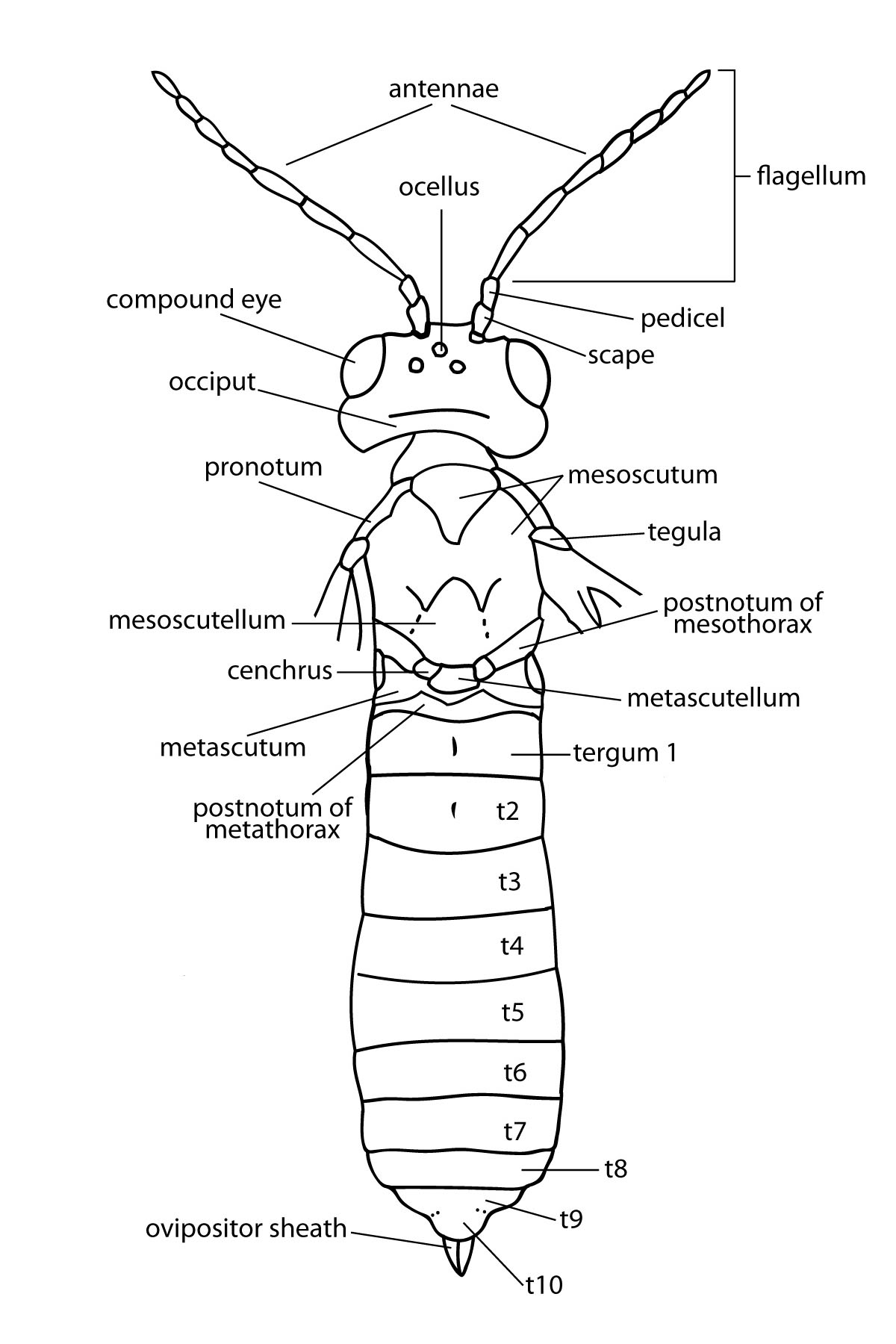 ridge extending from mandiblemandible:
ridge extending from mandiblemandible: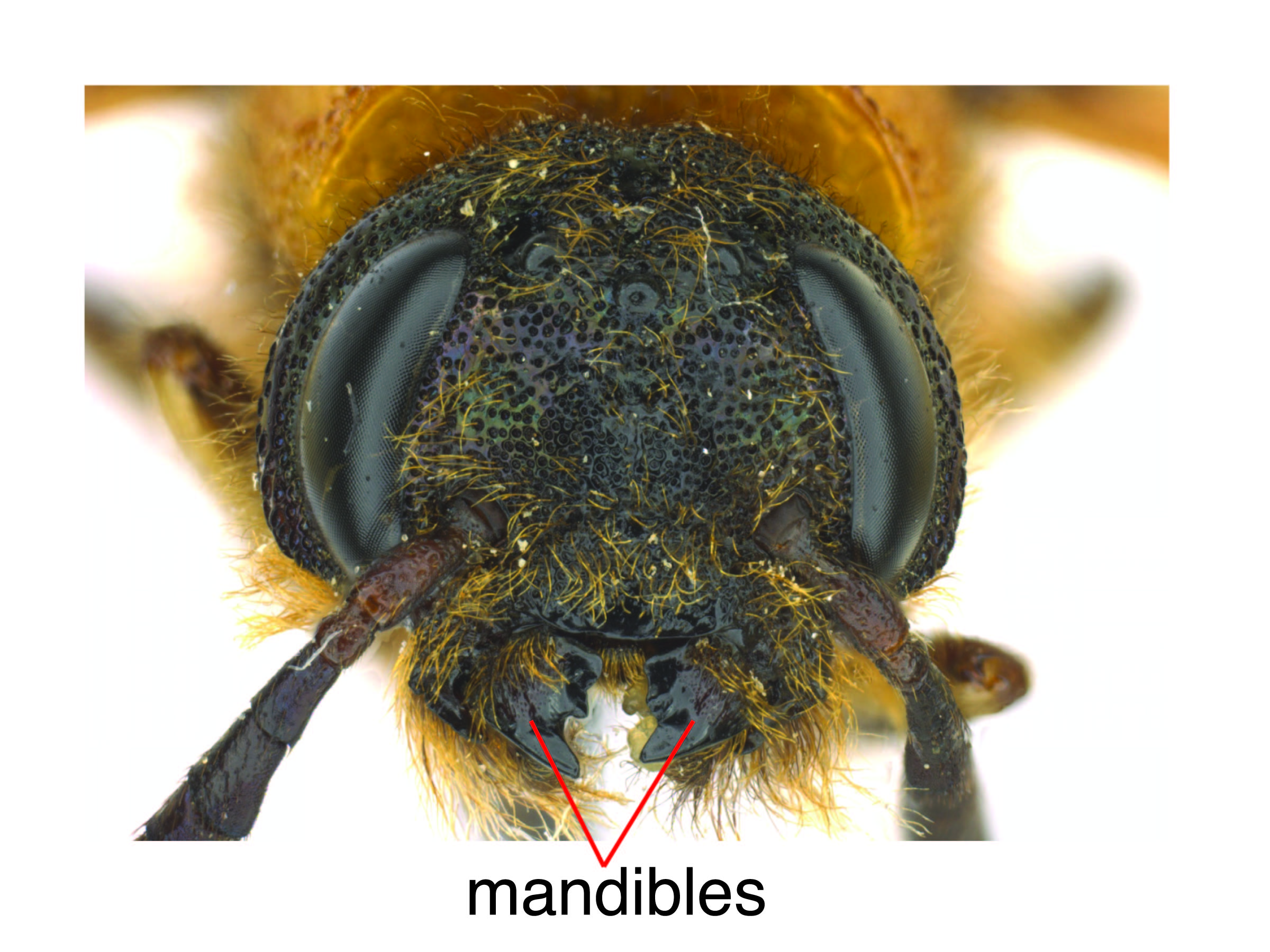 to near post-ocellar area (Goulet 1992Goulet 1992:
to near post-ocellar area (Goulet 1992Goulet 1992: vein 2A+3A complete, connected to 1A by crossveincrossvein:
vein 2A+3A complete, connected to 1A by crossveincrossvein: anal crossveinanal crossvein:
anal crossveinanal crossvein: vein 2r present (Goulet 1992Goulet 1992:
vein 2r present (Goulet 1992Goulet 1992: vein M intersecting Sc+R basalbasal:
vein M intersecting Sc+R basalbasal: vein 1m-cu and Cu1 120°–150° (Goulet 1992Goulet 1992:
vein 1m-cu and Cu1 120°–150° (Goulet 1992Goulet 1992: anal crossveinanal crossvein:
anal crossveinanal crossvein: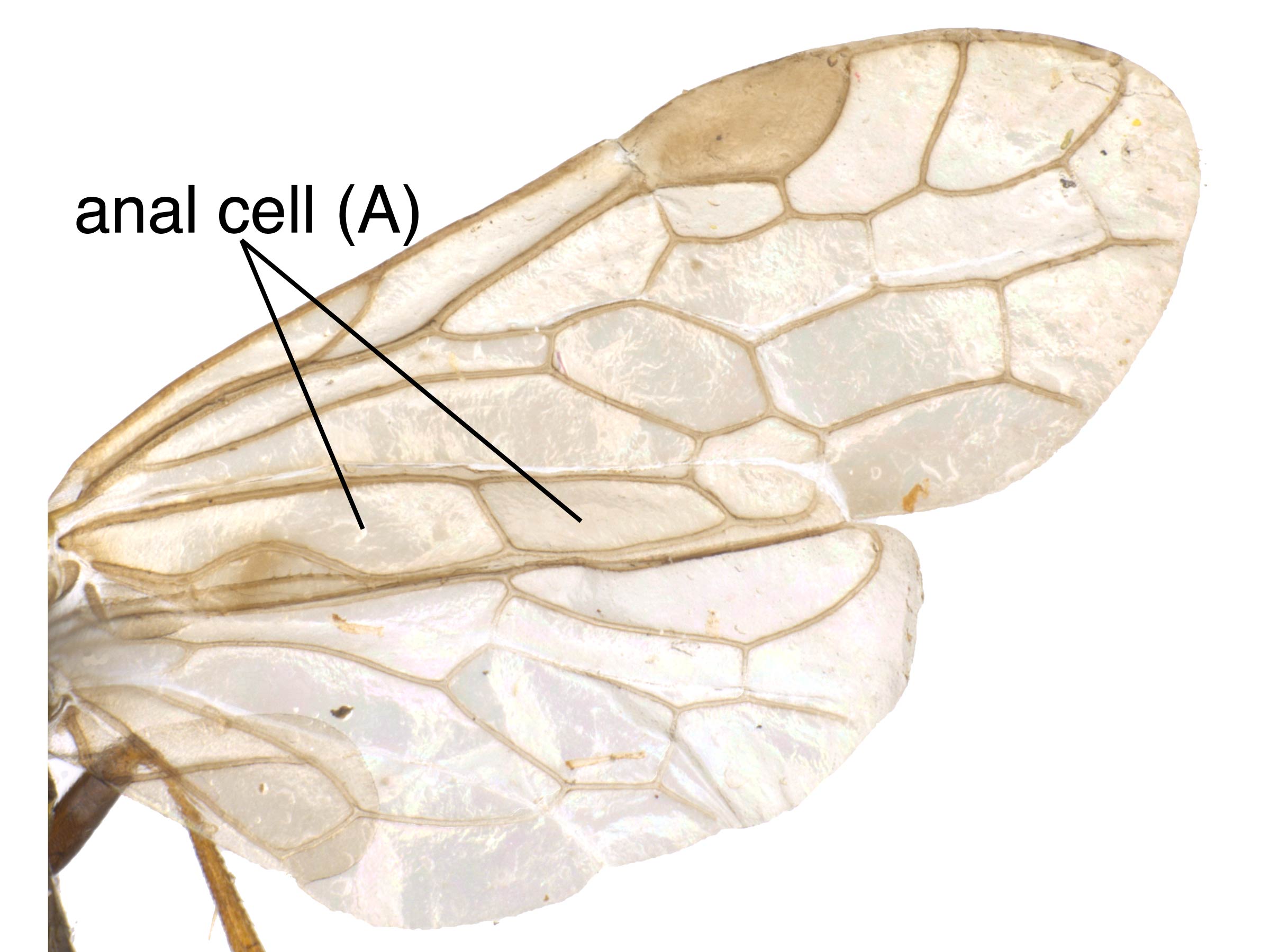 (Goulet 1992Goulet 1992:
(Goulet 1992Goulet 1992: obtusely angled on lower posterior corner (Goulet 1992Goulet 1992:
obtusely angled on lower posterior corner (Goulet 1992Goulet 1992: 3X medial length of postnotumpostnotum:
3X medial length of postnotumpostnotum:Tenthredo can be confused with similar species in the subfamily Tenthredininae. It can be distinguished from most other genera by the obtuse angle on the posteroventralposteroventral:
describes location towards the back on the underside of the body; posterior and ventral
area of the metepimeronmetepimeron:
the dorsal portion of the metapleuron
 and the ventralventral:
and the ventralventral:
of or on the underside of the body or structure
angle of the compound eye. Tenthredo can be distinguished from closely related Rhogogaster by the size of the eye, the apicalapical:
towards the apex; farthest away from the body
margin of the labrumlabrum:
a sclerotized structure on the front of the head between the clypeus and mandibles
 , and a furrowfurrow:
, and a furrowfurrow:
a groove or linear depression
 on the anterioranterior:
on the anterioranterior:
of or towards the front or head
pronotum (Goulet 1992Goulet 1992:
Goulet H. 1992. The genera and subgenera of the sawflies of Canada and Alaska: Hymenoptera. Symphyta. The insects and arachnids of Canada. Part 20. Agriculture Canada Publication.).
In China, T. nubipennis is considered a pest because of records of wide-scale damage in Phyllostachys bamboo forests. The species is univoltineunivoltine:
describing an insect with a life cycle of one generation per year
(Liang 2012Liang 2012:
Liang XM. 2012. Morphology and biology on Tenthredo nubipennis . Journal of Zhejiang Aamp;F University 29 (3): 431-434.). In Turkey, T. livida is a defoliating pest of Rosa spp. (rose) (Özbek and Çalmaşur 2005Özbek and Çalmaşur 2005:
Özbek H and Çalmaşur Ö. 2005. A review of insects and mites associated with roses in Turkey. In: Nybom H and Rumpunen K, eds. Proceedings of the 1st International Rose Hip Conference. Acta Horticulturae 690: 167–174. https://doi.org/10.17660/ActaHortic.2005.690.25).
Tenthredo in Europe feeds on a great diversity of plants from several plant families, but most hosts for species in North America are unknown. Species are often host-specific (Goulet 1992Goulet 1992:
Goulet H. 1992. The genera and subgenera of the sawflies of Canada and Alaska: Hymenoptera. Symphyta. The insects and arachnids of Canada. Part 20. Agriculture Canada Publication., Goulet 1996Goulet 1996:
Goulet H. 1996. Revision of the nearctic species of the Arcuata group of the genus Tenthredo with notes on the higher classification of the Tenthredinini (Hymenoptera: Symphyta, Tenthredinidae). Contributions of the American Entomological Institute 29 (2): 1-135.). Tenthredo xantha feeds on Rubus (blackberry) (Smith and Middlekauff 1987Smith and Middlekauff 1987:
Smith DR and Middlekauff WW. 1987. Suborder Symphyta. In: Stehr FW ed. Immature Insects. Kendall/Hunt Publishing Company. Vol. 1: 754 pp.), and T. grandis feeds on Chelone (turtlehead) (Stamp 1984Stamp 1984:
Stamp NE. 1984. Effect of defoliation by checkerspot caterpillars ( Euphydryas phaeton ) and sawfly larvae ( Macrophya nigra and Tenthredo grandis ) on their host plants ( Chelone spp.). Oecologia 63: 275-280.).
Specific biology for many species is unknown. Tenthredo is univoltineunivoltine:
describing an insect with a life cycle of one generation per year
, and prepupae often overwinter in cells or cocoons in the ground (Smith and Middlekauff 1987Smith and Middlekauff 1987:
Smith DR and Middlekauff WW. 1987. Suborder Symphyta. In: Stehr FW ed. Immature Insects. Kendall/Hunt Publishing Company. Vol. 1: 754 pp.).
Tenthredo grandis has been recorded causing severe defoliation of turtlehead in the eastern United States. This feeding preference imposes limitations on Euphdryas phaeton (Baltimore checkerspot), a butterfly that shares this host, resulting in possible population decline of this rare and threatened butterfly (Stamp 1984Stamp 1984:
Stamp NE. 1984. Effect of defoliation by checkerspot caterpillars ( Euphydryas phaeton ) and sawfly larvae ( Macrophya nigra and Tenthredo grandis ) on their host plants ( Chelone spp.). Oecologia 63: 275-280.).
Adults are recorded feeding on pollen and nectar of non-host plant flowers, pollinating the plant in the process. Tenthredo and closely related Rhogogaster are the only confirmed North American sawfly pollinators (there is evidence of Arge carrying pollen). There are also records of adults predating on other insects, including Syrphidae flies and other, smaller sawflies. Pollination and predation are ecosystem services that may provide positive economic impact (Smith 1979bSmith 1979b:
Smith DR. 1979b. Symphyta. In: Krombein KV, Hurd PD, Jr., Smith DR, and Burks BD (eds). Catalog of Hymenoptera in America North of Mexico. V. 1. Smithsonian Institution Press, Washington DC. pp. 1-137., Liston 1980Liston 1980:
Liston AD. 1980. Why sawflies of the Tenthredo arcuata-schaefferi complex (Hymenoptera, Tenthredinidae) visit flowers. Annales Zoologici Fennici 46: 85-88., Goulet 1996Goulet 1996:
Goulet H. 1996. Revision of the nearctic species of the Arcuata group of the genus Tenthredo with notes on the higher classification of the Tenthredinini (Hymenoptera: Symphyta, Tenthredinidae). Contributions of the American Entomological Institute 29 (2): 1-135.).
Some plants pollinated by Tenthredo in North America include Potentilla (cinquefoil), Luetkia (partridge-foot), Ledum (wild rosemary), Monardella, Cymopterus (springparsley), Senecio (ragwort), Solidago (goldenrod), Pedicularis, Salix (willow), Horkelia, Ranunculus (buttercup), Arnica, Valeriana (valerian), Polygonum (knotweed), Phacelia, and Hackelia (Goulet 1996Goulet 1996:
Goulet H. 1996. Revision of the nearctic species of the Arcuata group of the genus Tenthredo with notes on the higher classification of the Tenthredinini (Hymenoptera: Symphyta, Tenthredinidae). Contributions of the American Entomological Institute 29 (2): 1-135.).
World: The genus is generally HolarcticHolarctic:
describing the region of the Northern Hemisphere that includes both the Nearctic and Palearctic regions
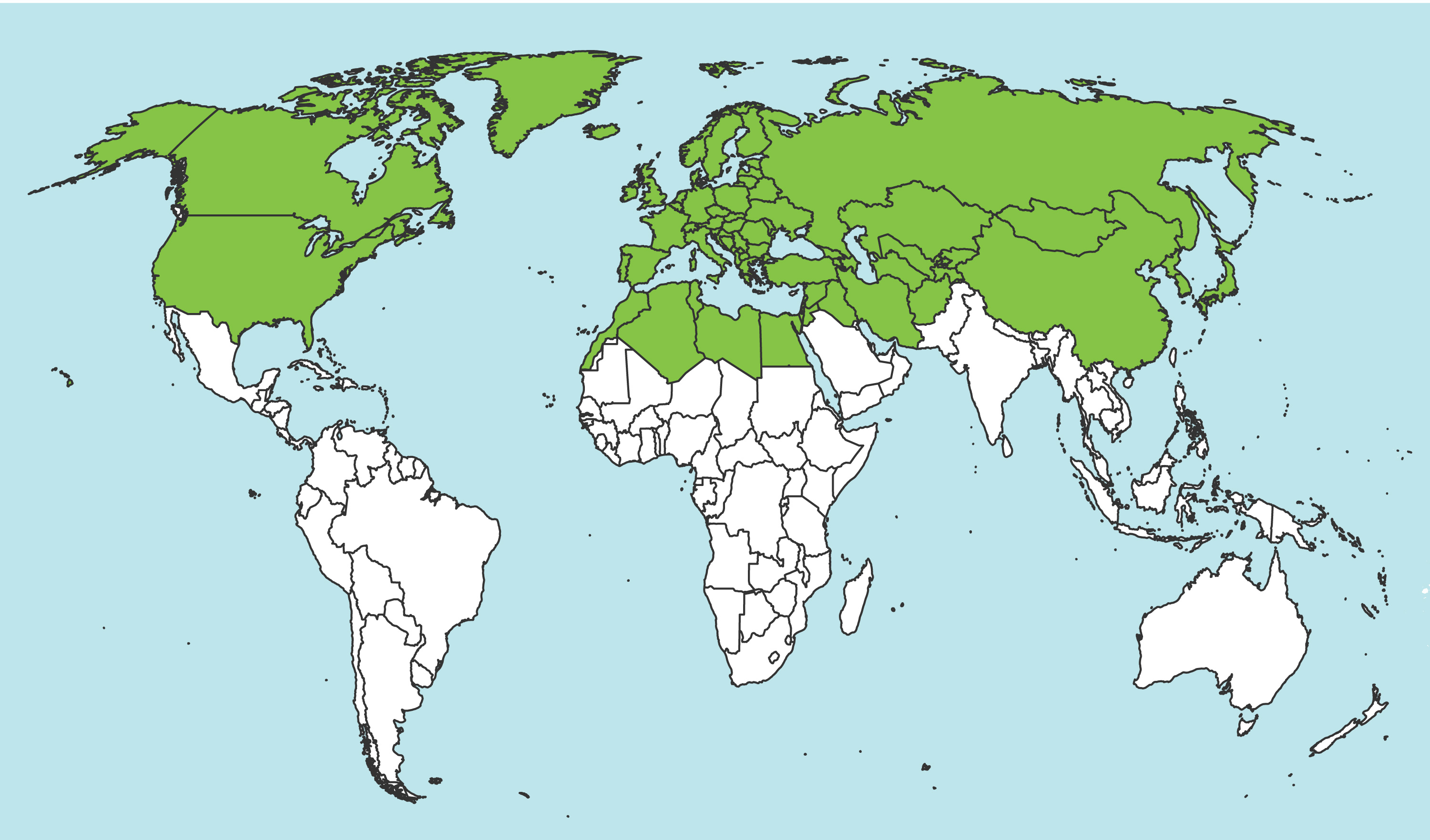 , present throughout North America, Europe, North Africa, and Asia (Smith 2003bSmith 2003b:
, present throughout North America, Europe, North Africa, and Asia (Smith 2003bSmith 2003b:
Smith DR. 2003b. A Synopsis of the sawflies (Hymenoptera: Symphyta) of America south of the United States: Tenthredinidae (Nematinae, Heterarthrinae, Tenthredininae). Transactions of the American Entomological Society 129 (1): 1-45., Taeger et al. 2010Taeger et al. 2010:
Taeger A, Blank SM, and Liston AD. 2010. World Catalog of Symphyta (Hymenoptera). Zootaxa 2580: 1-1064.).
North America: Tenthredo occurs throughout Canada and the northern United States. One species, T. ocampa, is recorded farther south in Chihuahua, Mexico (Smith 2003bSmith 2003b:
Smith DR. 2003b. A Synopsis of the sawflies (Hymenoptera: Symphyta) of America south of the United States: Tenthredinidae (Nematinae, Heterarthrinae, Tenthredininae). Transactions of the American Entomological Society 129 (1): 1-45.).
Map data from: GBIF.org (29 October 2019) GBIF Occurrence Download Tenthredo
Details about data used for maps can be found here.